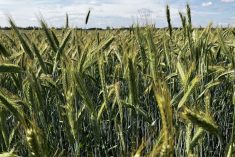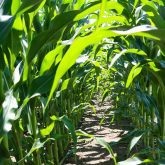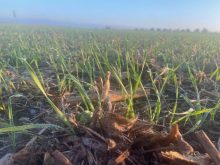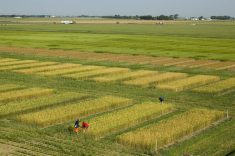Manitoba’s winter cereals are off to a good start.
Anne Kirk, cereals specialist with Manitoba Agriculture, and Alex Griffiths, agronomist with the winter wheat program of Ducks Unlimited Canada, both report plenty of fields in good shape, particularly those seeded in the prime window in early to mid-September.
“We have had some moisture this September, which is great for winter cereals,” Kirk said. “From what I’ve heard, the winter cereals that have been planted are coming up well and I think they’ll be going into winter in a good spot.”
Read Also

Time to be honest about hemp, experts say
Years of hype have given way to a more realistic view of hemp. Farmers and processors say the crop’s future depends on solid agronomy, honesty.
The dry start to the month likely didn’t hurt those crops. It doesn’t take much moisture for winter cereals to germinate, Kirk noted, particularly since the recommended seeding depth is shallow.
Why it matters: Mother Nature has set most winter cereals up for success.
Winter wheat sown within the recommended window is showing two or three leaves and some tillering, Griffiths estimated.
“It would be hard to say for the whole province, but I think we’re going to end up at least at or above the … amount of acres that we had this past year, which was roughly 75,000,” he said.
He has received more calls from producers interested in the crop than in any other year.
“I expected the acres to increase to probably above 100,000 acres, but the weather made harvest a bit more of a priority than seeding, so there (are) lots of folks who were unable to get their fields seeded. I’m not sure where it’s going to settle out,” he said.

Winter wheat acreage has played second fiddle to fall rye in Manitoba in recent years.
Statistics Canada estimates that 107,200 acres of fall rye were seeded coming into spring 2023.
There are also a number of later seeded winter cereal acres.
Producers had until Sept. 25 to get their winter cereals in for regular coverage through the Manitoba Agricultural Services Corporation, although extended seeding deadlines extended to Sept. 30.
Griffiths has heard of some producers seeding right up to that deadline.
“Those ones might be just barely poking out of the ground right now,” he said.
2023 oddities
Despite positive reports, there have been some left turns this fall, both experts noted.
Harvest was optimistically early. The Sept. 12 crop report from Manitoba Agriculture put harvest at 51 per cent complete, nine per cent ahead of the five-year average. That potentially set up winter cereals for a comeback compared to last year, when a wet spring pushed back the season and squeezed fall farm labour.
This year’s canola, typically the stubble of choice in which to plant winter cereals, had some challenges. Many acres lingered, Kirk noted.
“It was kind of an odd harvest for canola in that those plants did tend to stay green, so in some areas people combined their canola pretty early and in other areas it sat around for quite some time.”
Growers were also fighting with taller than normal canola, so much so that there were issues getting the crop through the swather. That may mean taller stubble for snow catch, since producers may have cut canola high to limit the biomass running through their equipment.
Griffiths also noted the harvest delay.
“Probably about half a dozen producers that I worked with that harvested winter wheat this fall, they harvested it in July, so I, at that point, thought that harvest would be wrapped up before the end of September for sure,” he said.
As weather in Manitoba is wont to do, however, fall brought rains and misty weather that prolonged harvest.
Griffiths also noted a surge in calls about alternative stubble options, such as barley or pea.
Peas don’t get as much snow catch, he said, but their early harvest make them attractive as a precursor to winter cereals.
Assessing stands
“Ideally, you want plants to have a well-developed crown going into winter and about three leaves,” Kirk said. “We don’t want them too big, or that can result in more winter kill or winter injury.”
In past years with very little moisture and less than prime conditions, smaller plants have proved they can also make it through the winter, depending on conditions.
Assessing wheat stands before winter can give growers an edge on how to manage the crop in spring and identify any seeding mistakes, according to Joanna Follings, cereals specialist with the Ontario Ministry of Agriculture, Food and Rural Affairs.
“It’s a great way to get out and see what’s going on and really know how accurate seeding was and how the crop is progressing before winter,” she said.
The best time to conduct a fall stand assessment is once all seedlings have fully emerged and it’s easier to distinguish individual plants and make stand counts to determine seeding rate accuracy. If soil conditions were dry at planting, emergence could be delayed.
Fall is not the time to determine whether to keep a stand, the Ontario expert said. The purpose of fall assessments is to gauge uniformity and planting depth accuracy.
“Uniformity of the stand should be noted as it may have implications for timing of crop protection products next spring,” said Follings.
“Any poor residue spread patterns in the field should also be noted and addressed in future years, if possible. If seedlings appear to be stressed or discoloured, they should be investigated further to determine if there’s the presence of barley yellow dwarf virus or other seedling diseases.”
The target density for a fall stand of winter wheat is around 30 plants per square foot, or about two bushels to the acre, both Griffiths and Kirk said. This allows for winter attrition.
In the spring, producers should hope for a stand around 20-25 plants per square foot, according to Kirk.
“But we know that winter wheat has a good ability to tiller, so if the plant stand is as low as, say, five to eight plants per square foot [come spring], it could still yield about 80 per cent of a normal stand.”
Griffiths said he commonly sees producers seeding too deep. Three-quarters of an inch to an inch is the recommended depth, and while chasing moisture can work in spring crops, the same is typically not true of winter wheat, which has a limited time once it breaks ground.
For crop consultant Peter Johnson, the fall stand assessment is also an opportunity to check on weed pressure. Growers can decide at that point whether to apply herbicide.
On very sandy or muck soils, manganese deficiency is something to watch for as the plants grow past three leaves.
“On very deficient soils, a manganese application in the fall may be warranted,” said Johnson.
“Deficient plants do not overwinter well. This is rare and you don’t need to include it, but it is the only nutrient we would worry about in the fall.”
















